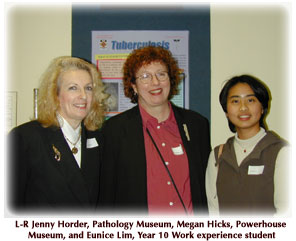2001-2002
"Big Pox, Smallpox and No Pox" Exhibition Launched
Professor
Denis Wakefield, Head of the School of Medical Sciences, said the three diseases showed
how the prevalence of disease can change. "Smallpox has been eradicated due to the
development of a very effective vaccine." Professor
Wakefield said the exhibition emphasised the importance of advances in disease treatment
and control. "An exhibition such as this enables young people to get a better
understanding of advances in medicine and medical research and where we might still be
today without that work. "It's very easy to take for granted some of the benefits of
modern medicine and not understand the sacrifices and long periods of waiting involved in
producing new, effective and safe treatments," he said. "The spasmodic outbreaks
of whooping cough and continued prevalence in our society of some diseases remind us of
the need for constant vigilance with infectious diseases," Prof Wakefield added. |
|

|
Professor
Wakefield said that even though the WHO was planning to destroy stocks of the smallpox
vaccine, possibly in 2002, people shouldn't be concerned that there won't be any vaccine
left. "Syphilis, once very common, is currently at a low level in Australia. But
tuberculosis, the subject of widespread prevention campaigns, is again on the increase in
Australia," he said. "In the past, TB led to some of the great discoveries of modern medicine,
including Laennec's discovery of the stethoscope, Koch's discovery of bacteria and
Roentegen's application of x-rays to diagnose tuberculosis. The history of the great poxes
should not be forgotten as we learn how to manage and prevent new threats to people's
lives." |
The exhibition includes specimens of diseased body parts and
artefacts loaned by the Powerhouse Museum, Hyde Park Barracks Museum, Society for the
Preservation of the Artefacts of Surgery and Medicine (SPASM) and the Northhead Quarantine
Station. The posters for the exhibition were designed with the assistance of Year 10 work
experience students. "The Big Pox, Smallpox and No Pox" exhibition is on until
the end of 2002. Bookings are essential. Phone 9385 2190. |
|
